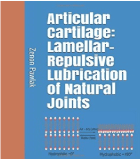Abstract
This monograph attempts to explain a new joint lubrication mechanism with surface active phospholipids as a lubricant. It provides studies of the principles of cartilage (smart material) of biological micro-and nanotribology.
Key words
articular cartilage, natural lubrication, lamellar-repulsive mechanism of lubrication of natural joints
Book Review
This monograph present2021 Copyright OAT. All rights reservar surface physics and biochemistry with an emphasis laid on the lamellar-repulsive mechanism of lubrication. Frictionless mechanical interaction of the charged positively, charged negatively and neutral surfaces (cartilage/cartilage; (+/+); (-/-); neutral (±)/(±)) is strictly educational for biomechanical engineering.
The first part of the book reviews the results of structure, composition and function of the cartilage phospholipid (PL) bilayers as a potential solid lubricant. The authors’ original contributions, focused on interfacial energy of PL bilayers with the emphasis lay on amphoteric character of fixed charged cartilage surfaces, are quite original.
The second part of the book deals with the friction vs wettability and presents the condition of cartilage surface correlated with surface wettability (contact angle). A change in natural cartilage surface energy leads to conformational changes in the surface of bovine patella from bilayer (super hydrophilic, ~0o contact angle wettability) to monolayer (hydrophobic 104o contact angle wettability) during the process of air-drying. The biological tissue of the cartilage in its natural condition, transforming from the hydrophilic to hydrophobic condition, can be named a “smart material”.
The third part of the book consists of chapters covering regeneration, resurfacing and restoration of the degraded surfaces, as well as the challenges and possibilities of achieving a biological knee repair for human patients.
All these experimental facts including surface energy, wettability, friction measurements were performed by the author when studying the boundary-layered friction supporting the lamellar—repulsive mechanism of lubrication of natural joints.
The biotribological model described in the monograph provides a new approach to the lubrication of natural joints and it certainly deserves to be learned by students. In the opinion of the Reviewer, investigations of the lamellar-electrostatic lubrication mechanism are very useful and innovative and deserve to be at the library.
This monograph is intended for advanced undergraduate and graduate students and researches active in the area of biomechanics and with biological systems, and engineers interested and involved in the sciences of nanomaterials (Glimpse of Book in Figure 1).

CONTENTS
1.0 Introduction 1
2.0 The structure, composition and function of cartilage 5
2.1 Synovial fluid 11
2.2 Phospholipid bilayers as a potential solid lubricant 17
2.3 Phospholipids 21
2.4 Cartilage and antiphospholipid antibody syndrome 25
3.0 Surface cartilage characteristics 35
3.1 Interfacial energy of PL bilayers 39
3.2 Cartilage surface wettability vs. pH 45
3.3 Friction vs. wettability of cartilage surface 53
3.4 Amphoteric cartilage and its consequences 64
3.5 Cartilage surface charge density vs. pH 75
4.0 Porosity of lubricated cartilage surface 85
5.0 The boundary and boundary-layered lubrication 89
6.0 Lamellar-repulsive mechanism of low friction in Nature 93
7.0 Resurfacing cartilage surface 107
8.0 Articular cartilage restoration and regeneration 123
9.0 Summary and outlook 131
About the Author 137
Bibliography 139
Index 153
References
Pawlak, Zenon (2018) Articular Cartilage: Lamellar-Repulsive Lubrication of Natural Joints, Kindle Direct Publishing, 171pp. Print-book: https://www.amazon.com/dp/B07B42P1JY, e- book: https://www.amazon.com/dp/1976760283.

